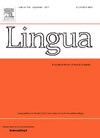亲属关系术语的概念基础
IF 1.3
3区 文学
0 LANGUAGE & LINGUISTICS
引用次数: 0
摘要
亲属术语曾经是结构语言学的一个主要焦点,但结构语言学的神秘符号和符号不能合理地代表说话者的认知现实,因此对今天的认知语言学家没有什么吸引力。本研究旨在将亲属语义学重新置于认知语言学的议程上。研究表明,亲属关系用语的象征性概念意义可以用人们理解的普通语言词汇成功地模拟出来;此外,这种方法支持系统的跨语言比较。这项研究代表了Wierzbicka亲属术语的“普通语言模型”的重新启动,保留了出生和概念作为原型,同时将模型转移到社会领域。“母亲”和“父亲”的修订解释考虑到收养和类似做法。对“妻子”和“丈夫”提出了最初的解释。在承认文化差异的同时,有人认为这四个概念(“母亲”、“父亲”、“丈夫”、“妻子”)在世界语言文化中可能有很大的共通之处。有了这些基本的概念构建块,通过使用英语、汉语和Pitjantjatjara的例子,可以以系统的方式建立不同语言特定的亲属概念。本研究概述了一种独特的认知语言学方法来研究亲属术语的概念语义。本文章由计算机程序翻译,如有差异,请以英文原文为准。
The conceptual building blocks of kinship terminologies
Kinship terminology was once a major focus of structural linguistics, yet the arcane symbols and notations of structural linguistics cannot plausibly represent the cognitive realities of speakers, and therefore hold little appeal for today’s cognitive linguists. This study seeks to put kinship semantics back on the cognitive linguistics agenda. It demonstrates that the emic-conceptual meanings of kinship terms can be successfully modelled using ordinary language words which make sense to the people concerned; and, furthermore, that this approach supports systematic cross-linguistic comparison. The study represents a re-boot of Wierzbicka’s “ordinary-language model” of kinship terminologies, retaining birth and conception as prototypes while shifting the model into the realm of the social. Revised explications of ‘mother’ and ‘father’ take account of adoption and similar practices. Original explications are proposed for ‘wife’ and ‘husband’. While acknowledging cultural elaborations, it is argued that these four concepts (‘mother’, ‘father’, ‘husband’, ‘wife’) may be substantially shared among the world’s linguacultures. With these basic conceptual building blocks in hand, it is demonstrated, using examples from English, Chinese, and Pitjantjatjara, that diverse language-specific kinship concepts can be built up in a systematic fashion. The study overviews a distinctive cognitive linguistic approach to the conceptual semantics of kin terms.
求助全文
通过发布文献求助,成功后即可免费获取论文全文。
去求助
来源期刊

Lingua
Multiple-
CiteScore
2.50
自引率
9.10%
发文量
93
审稿时长
24 weeks
期刊介绍:
Lingua publishes papers of any length, if justified, as well as review articles surveying developments in the various fields of linguistics, and occasional discussions. A considerable number of pages in each issue are devoted to critical book reviews. Lingua also publishes Lingua Franca articles consisting of provocative exchanges expressing strong opinions on central topics in linguistics; The Decade In articles which are educational articles offering the nonspecialist linguist an overview of a given area of study; and Taking up the Gauntlet special issues composed of a set number of papers examining one set of data and exploring whose theory offers the most insight with a minimal set of assumptions and a maximum of arguments.
 求助内容:
求助内容: 应助结果提醒方式:
应助结果提醒方式:


